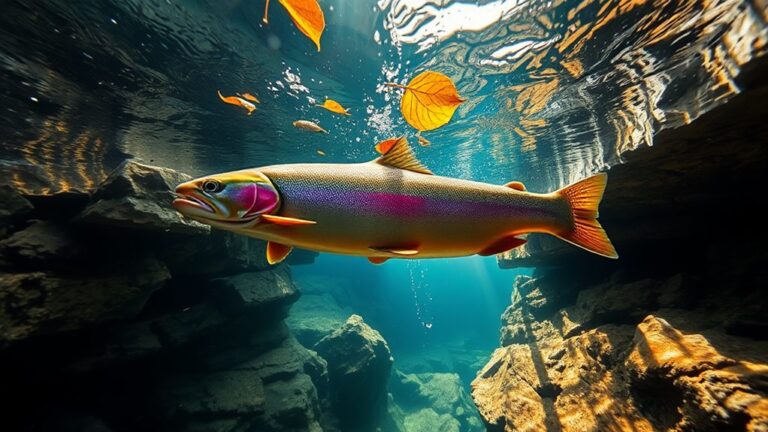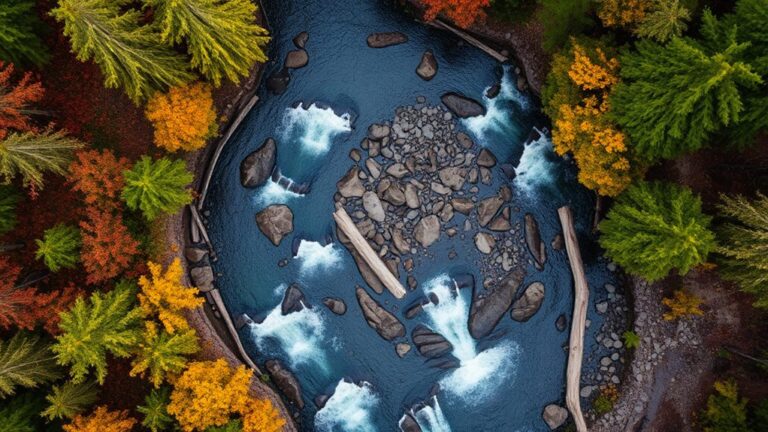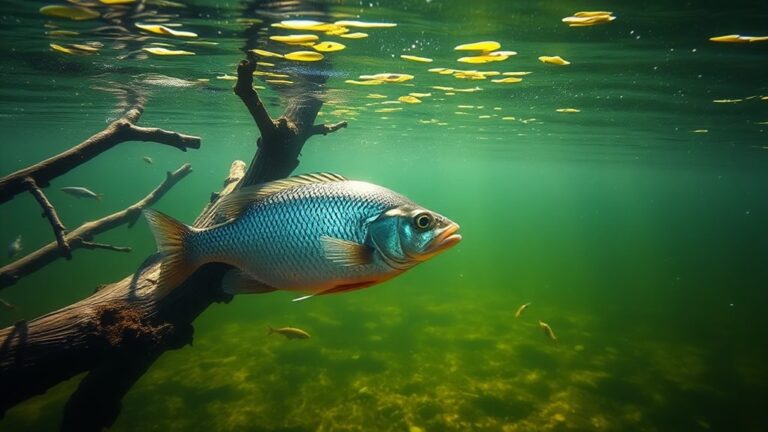You'll catch more shallow crappie by mastering these five proven techniques during spring and early summer. Start by sight fishing from shore using polarized sunglasses to spot fish in clear, shallow waters. Target pre-spawn staging areas near brush piles and fallen trees where crappie gather. Try trolling with light tackle at slow speeds using bright-colored jigs under bobbers. Vertical jigging near structure with small jigs and soft plastics can be highly effective. Finally, suspend live minnows under slip bobbers positioned above submerged cover. These fundamental approaches will help you reveal the secrets of consistently landing more shallow crappie.
Sight Fishing From Shore

When spring arrives and water temperatures hit 60°F, you'll find crappie moving into the shallows for their annual spawning ritual. This is your perfect opportunity to try sight fishing from shore, where you can spot these fish in clear water as they guard their spawning sites.
To get started, you'll need a good pair of polarized sunglasses – they're absolutely vital for cutting through water glare and spotting crappie movement. Look for areas with cover like submerged logs or weed beds in shallow water between 2-8 feet deep, as these are prime spawning locations.
Remember to approach these spots quietly and carefully. Crappie are especially skittish during spawning season, and one wrong move can send them scattering.
Once you've located your target, try various jigging techniques with small, bright-colored lures. Watch for subtle movements like swirls or wakes near the surface – these are telltale signs of active fish.
Keep your movements minimal and your presentation precise. When you spot a crappie, gently work your bait in their direction. They're more likely to strike when they can see your lure clearly in the shallow water.
Targeting Pre-Spawn Staging Areas
Savvy anglers know that catching pre-spawn crappie starts with identifying their staging areas in shallow waters. You'll find these fish gathering in depths of 2-8 feet near spawning cover as they prepare for their annual ritual. When water temperature approaches 60°F, it's time to grab your gear and head to these productive zones.
Look for these staging spots near structure that attracts baitfish, such as brush piles and fallen trees. Your polarized sunglasses will help you spot both structure and fish, making your approach more targeted. Small jigs and live minnows under a bobber are your best bets for enticing these hungry pre-spawners.
| Location Type | Depth Range | Best Bait Choice |
|---|---|---|
| Brush Piles | 2-4 feet | Small Jigs |
| Fallen Trees | 4-6 feet | Live Minnows |
| Rock Piles | 6-8 feet | Tube Baits |
Remember to work these areas thoroughly, as pre-spawn crappie often cluster together in prime spots. Keep your presentations slow and deliberate, allowing the bait to stay in the strike zone longer. With the right approach and patience, you'll connect with these shallow-water specialists during this prime fishing period.
Trolling With Light Tackle
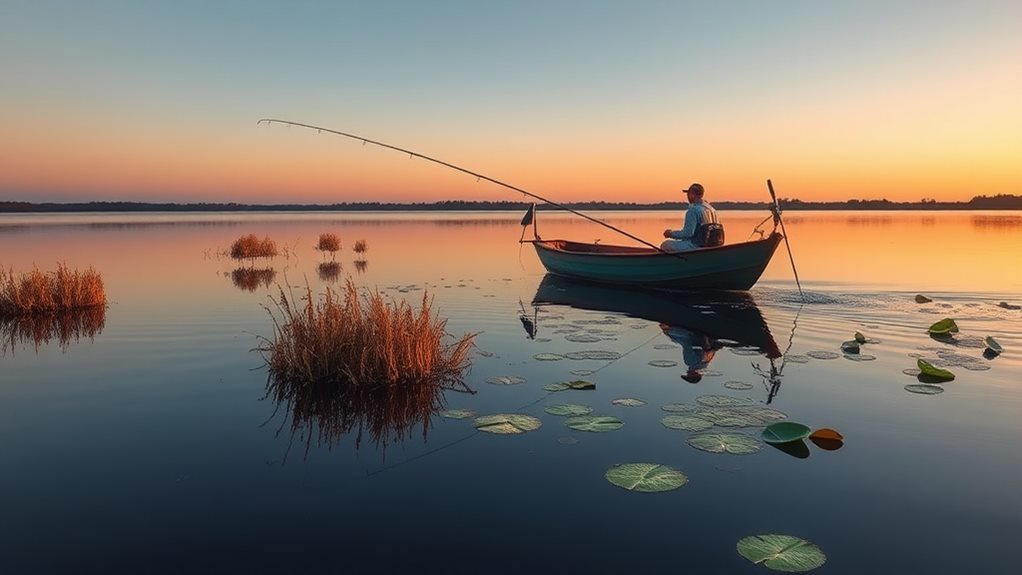
Trolling with light tackle offers a highly effective method for catching shallow crappie, especially when you're equipped with the right gear.
You'll want to start with a sensitive light rod between 5.5 to 6 feet in length, paired with a 4lb test line that'll help you detect even the most subtle bites from these finicky fish. Similar to basic fishing techniques, maintaining proper body position and smooth casting motions will help you make the most of your setup.
When you're crappie fishing in shallow waters, maintaining the right trolling speed is essential. Keep your pace between 0.5 to 1.0 mph, which perfectly mimics the movement of natural bait fish.
For best results, tie on a 1/32oz jig in attention-grabbing colors like hot pink or chartreuse, and don't forget to add a soft plastic trailer for extra appeal.
To maximize your success, position a stand-up bobber about 1.5-2 feet above your jig. This setup keeps your bait suspended in the prime strike zone, typically 2-8 feet deep where crappie tend to hang out during warmer months.
The bobber not only helps maintain the perfect depth but also acts as a visual indicator when those light-biting crappie decide to take a swing at your offering.
Vertical Jigging Near Structure
Vertical jigging near structure stands out as one of the most reliable techniques for catching shallow crappie. When you're working submerged structures like fallen trees and brush piles in 2-8 feet of water, you'll find these fish congregating in predictable patterns, especially during spawning season.
To maximize your success, you'll want to outfit yourself with a light jigging rod and a 1/32oz jig head. You can tip this with either a soft plastic grub or live minnow – both work wonderfully for enticing strikes. The key is maintaining a slow, deliberate jigging motion that mimics natural prey movement.
Position your boat directly over underwater cover where crappies are holding. You'll need to pay close attention to your depth, keeping your bait just above the fish's eye level. Remember, crappies typically face upward when feeding, so this positioning is vital.
Make subtle adjustments to your jigging height until you find the sweet spot where they're actively striking.
Pro Tip: When you locate a productive piece of structure, mark it on your GPS – these spots often hold fish consistently throughout the season.
Suspended Minnow Techniques
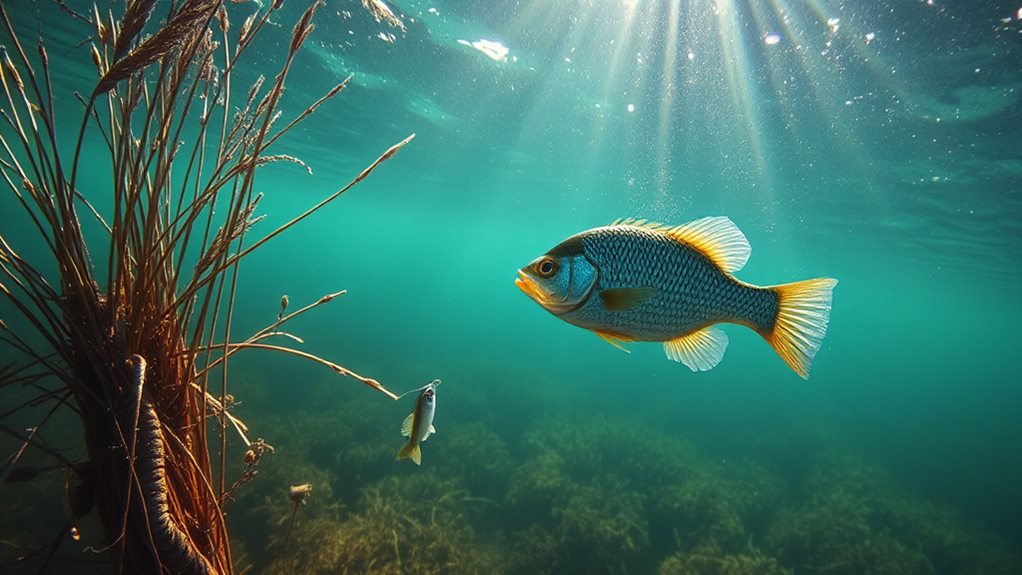
Success with suspended minnow techniques hinges on precise bait presentation and proper rigging. You'll want to start by setting up a slip bobber rig that positions your live minnows about 1.5-2 feet above the bottom in shallow waters. This setup gives you the control you need while keeping your bait in the strike zone where hungry crappie are likely to spot it.
When implementing suspended minnow techniques, you'll need to pay attention to two critical factors: location and temperature. Position yourself near submerged structures like brush piles or fallen trees, as these spots are crappie magnets. Keep an eye on your thermometer – the sweet spot for crappie activity is between 60-75°F, when they're most actively feeding.
Don't forget to match your gear to crappie behavior. Use small hooks (sizes 4-6) to protect their tender mouths and guarantee solid hooksets.
As the day progresses, you'll need to adjust your minnow depth based on where the fish are suspending. They might be shallow in the morning, then move deeper as the sun rises – so stay flexible with your presentation and depth adjustments.
Frequently Asked Questions
How Shallow Will Crappie Go?
You'll find crappie swimming in water as shallow as 2 feet deep, especially during spawning season. They're comfortable in shallow depths between 2-10 feet when conditions like water clarity and temperature are right.
What Water Temperature Do Crappie Move Shallow?
You'll find crappie moving shallow when water temperatures reach around 60°F. They'll become even more active in shallow areas at 65-70°F, with peak spawning activity occurring when temperatures hit 70°F.
What Is the Secret to Catching Crappie?
You'll catch more crappie by using light tackle, small jigs tipped with soft plastics, and fishing shallow waters during spawning. Focus on 2-8 foot depths when water hits 60°F, targeting structure like brush.
What Is the Best Depth to Catch Crappie?
You'll find crappie at 2-8 feet during spawning season, 30-50 feet in fall, and 10-20 feet in late fall. During summer, target 15-25 feet when water's warm, and check 10-18 feet post-spawn.


